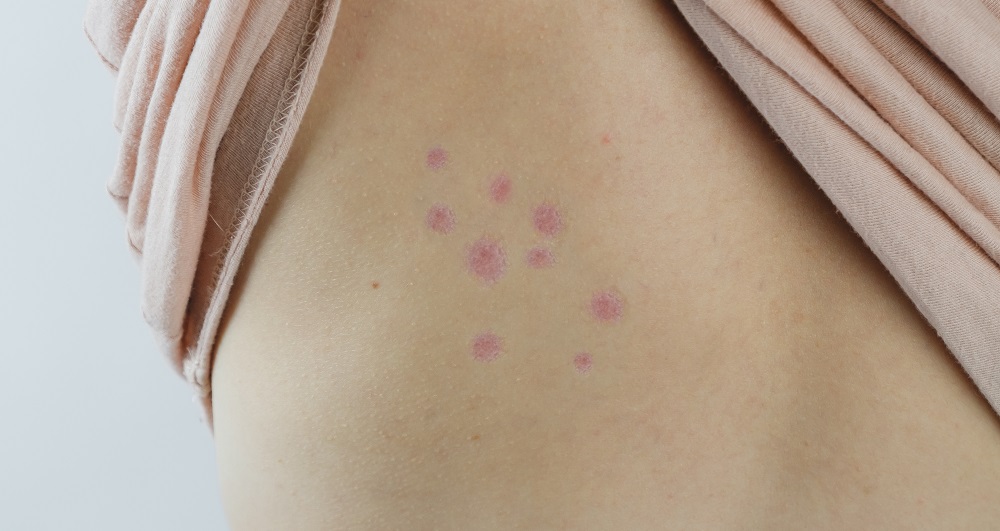There has been a resurgence of bed bugs in recent years. Aside from being a nuisance, there have been concerns that bed bugs might transmit pathogens and cause diseases in humans. Many pregnant women would, thus, like to know if there may be any effects of exposure to bed bugs to their unborn babies.
Fortunately, bed bugs are not known to transmit communicable diseases in humans. A bite from bed bugs during pregnancy would also not have any direct consequence to the well-being of the fetus. Still, their bites can cause discomfort to pregnant women and may lead to more serious complications like systemic reactions or anaphylaxis.
Jesmarie Macapagal, RN, MD, DPPS
What are Bed Bugs?
Bed bugs are nocturnal parasites that have adapted to feed on the blood of humans (Potter, 2011) or other warm-blooded animals. They are small (5 to 7 millimeters in length), oval and brownish in color and have flat bodies with a size like that of an apple seed. However, after a feed, their bodies swell and become a reddish shade.

Bed bugs are not able to fly, but can move around quickly over the floors, walls and ceilings. Female bed bugs can lay hundreds of eggs over their lifetime. The size of one egg is like a speck of dust.
Nymphs are immature bed bugs that shed their skin five times before reaching an adult phase. They require a blood meal each time before shedding. A bed bug can fully mature in just one month and can produce at least three generations every year.
Where Bed Bugs Live
Bed bugs live inside homes and favor feeding on humans. They often hide near sleeping or resting places indoors (Jones, 2021). Beds, mattresses, sofas, and curtains are frequently infested areas (Delaunay, 2012).
Their flat shape and ability to climb also allow them to hide in narrow crevices and cracks anywhere in the house, from floor to ceiling (Jones, 2021). Typical hiding places of bed bugs include mattresses, box springs, bed frames and headboards, where they could have an easy access to bite their host in the night.
About 80 percent of bed bugs stay hidden. Only those that are hungry and want to feed attempt to go outside their hiding places (Reis & Miller, 2011). Bed bugs move by active displacement to feed in the night (Delaunay, 2012).
How Far Bed Bugs Spread
Bed bugs can also spread to nearby rooms or apartments. As stated by the U.S. Environmental Protection Agency (EPA), bed bugs are “a pest of significant health importance” (Lai et al., 2016). Active dispersal of bed bugs along infested and neighboring apartments has been shown as one of the causes for the spread of bed bugs in communities (Cooper et al., 2015).
Bed bugs are able to walk long distances indoors (Jones, 2021). In 2010, Wang et al. reported that bed bugs can spread from a single apartment to 53 percent of the adjacent apartments in a high-rise building with 223 units in just a period of 41 months.
In 2015, Cooper et al. investigated the movements of bed bugs within and between apartments. Their findings suggest that there is extensive movement of bed bugs regardless of their number and whether there is a host present or not. In a vacant apartment with no available host, large nymphs continued to be recovered up to 57 days, adult females up to 113 days, and adult males up to 134 days.
Bed bugs also hitch a ride on items and furniture, and are easily transported to new locations (Jones, 2021). Aside from active dispersal, several passive mechanisms of dispersal were also observed (Wang et al., 2010):
- Bringing in bed bug-infested furniture
- Travel of hosts
- Resident turnover
- Resident visits
- Used of bed bug-infested wheelchair in common areas of the building
Bed bugs have been detected in aircraft, boats, trains and hotels, thereby travelers may be particularly at risk of exposure and infestation (Delaunay, 2012).
Can Bed Bugs Cause Illness to Pregnant Women?
There are concerns that the worldwide spread of bed bugs may lead to outbreaks of infestations and that bed bugs may be a vehicle of transmission for human pathogens. However, up to this time, no published research has shown a causal relationship between bed bugs and transmission of infectious disease to humans (Lai et al., 2016).
Bed bugs may bite any exposed areas of the skin while feeding on a host during sleep. Common locations for bites include the face, neck, hands and arms.
Some people may have no visible skin reaction even after repeated bites from bed bugs or multiple bites over time (Dang et al., 2017). But about 70 percent of individuals who get bitten by bed bugs experience some form of an allergic reaction, which can range from mild to severe, such as pruritus, erythematous rash, or urticaria (Dang et al., 2017).
The common skin response to bed bug bites is an itchy maculopapular wheal (Delaunay et al., 2011). Formation of itchy rashes is a relatively benign reaction that resolves in just about 1 hour after the bite (Rahim et al., 2016).

Systemic urticarial reactions, on the other hand, are more severe and may happen from repeated bites. These include symptoms of itchiness, swelling of the face, lethargy, profuse sweating, widespread wheals all over the body, chest tightness, and even difficulty of breathing. Treatment with systemic prednisone and antihistamines can cure the symptoms within 4 or 5 hours (Minocha et al., 2015).
In addition, scratching of the bites can lead to secondary bacterial infections and the development of cellulitis, impetigo, ecythma and lymphangitis (Dang et al., 2017). Numerous bites from bed bugs can also lead to anemia, and the allergens from their bites can trigger an asthmatic reaction (Doggett et al., 2012).
More importantly, bed bugs have been reported to transport over 40 pathogens in their stomach, feces, exoskeleton and saliva (Delaunay et al., 2011). However, there is no definitive evidence that bed bugs are able to transmit any disease-causing pathogen to humans (Doggett et al., 2012).
Various empirical treatments, including antibiotics, antihistamines, topical and oral corticosteroids, and epinephrine, have been used for reactions from bed bug bites with different results. In spite of this, there is no evidence-based intervention known to eradicate bed bugs or to prevent bites. Likewise, there is no evidence that outcomes change whether a patient receives treatment or not (Goddard & deShazo, 2009).
For pregnant women who get bitten by bed bugs, topical medications to relieve itching like calamine lotion may be used. However, natural remedies are preferred to avoid unnecessary exposure to potentially harmful chemicals and their effects to unborn babies. These include washing the bite with soap and water instead of scratching.
For professional medical advice on how to manage bites from bed bugs, pregnant women should visit their most trusted health care providers.
Signs of a Bed Bug Infestation
If an infestation of bed bugs is suspected, steps to get rid of the bugs and prevent their return must be undertaken. The following are common signs of an infestation:
- Waking up with itchy wheals or papules that were not there when you went to sleep
- Blood stains on the pillowcases or bed sheets
- Dark or rusty spots of bed bug feces on bed sheets, mattresses or walls
- Bed bug fecal spots, egg shells or shed skin in crevices
- A musty odor from the bed bugs’ odor glands
How to Eradicate Bed Bugs During Pregnancy
Complete eradication of bed bugs is difficult because they are very mobile and they can travel expansively across neighboring units (Cooper et al., 2015), on top of an increasing resistance to commonly used insecticides and health concerns about spraying pesticides in the home.
Due to their low toxicity to mammals, pyrethroid insecticides are primarily used to control bed bug infestations (Davies et al., 2012). However, pyrethroid resistance in bed bugs has also been reported worldwide (Balvin & Booth, 2018). In Germany, Vander Pan et al. (2019) tested the efficacy of using pyrethroid insecticides against bed bugs, and found that up to 26 to 50 percent of the bed bugs still survived and even laid eggs.
Moreover, using bug spray during pregnancy could be dangerous. Insecticides contain chemicals that attack the nervous system of insects, causing them to die. These same chemicals can also attack the human brain. During pregnancy, the rapidly developing fetal neural tube and nervous system are highly susceptible to adverse effects from exposure to pesticides (Bjørling-Poulsen et al., 2008).
Therefore, all pregnant women must avoid any contact with insecticides (Greenop et al., 2013). The safest way is to prevent a bed bug infestation. Items that are bought from garage sales or resale shops, most especially mattresses, box springs and beddings, should all be cautiously checked for the presence of bed bugs before they are brought inside a home.
Tips for Dealing with Bed Bugs
- Clean beddings, linens, curtains and clothing in hot water, then dry using the highest dryer setting.
- Use a stiff brush to scrub mattress seams to dislodge bed bugs and their eggs before vacuuming.
- Vacuum the bed and surrounding areas frequently.
- After vacuuming, place the vacuum bag immediately in a plastic, then seal it and throw outdoors.
- Encase mattresses and box springs with a tightly woven, zippered cover for at least one year to ensure that all bed bugs that may be present are dead.
- Patch up cracks in the plaster and glue down any peeling wallpaper to eradicate any place for bed bugs to hide.
Final Thoughts
Bed bugs are troublesome parasites that can be hard to deal with once they have infested your home. If an infestation is suspected, begin the process of eradicating them immediately and completely to make sure that they do not return.
However, the use of insecticides can be dangerous for the fetal brain. Pregnant women must, therefore, avoid any contact with bug sprays. Rather, all measures to prevent the occurrence and entry of bed bugs must be vigilantly taken.
Bed bug bites during pregnancy are not known to cause any harm to the unborn fetus. Currently, there is no evidence that bed bugs are able to transmit diseases to humans. Nevertheless, their bites can still cause discomfort and itch, and can lead to more severe allergic and systemic reactions.
Pregnant women who think they may have been bitten by bed bugs should consult their health care providers for appropriate medical management.
References
- https://www.webmd.com/skin-problems-and-treatments/guide/bedbugs-infestation
- https://www.medicinenet.com/bed_bugs/article.htm
- https://www.webmd.com/skin-problems-and-treatments/news/20090331/bedbugs-are-pesky-but-not-harmful
- https://americanpregnancy.org/healthy-pregnancy/is-it-safe/pesticides-during-pregnancy/
- https://bedbugsos.ca/blogs/edu/are-bed-bug-bites-dangerous-during-pregnancy
- Balvin, O., & Booth, W. (2018). Distribution and frequency of pyrethroid resistance-associated mutations in host lineages of the bed bug (Hemiptera: Cimicidae) across Europe. Journal of Medical Entomology 55(4), 923-928. doi: 10.1093/jme/tjy023
- Bjørling-Poulsen, M., Andersen, H. R., & Grandjean, P. (2008). Potential developmental neurotoxicity of pesticides used in Europe. Environmental Health 7, 50. doi: 10.1186/1476-069X-7-50
- Cooper, R., Wang, C., & Singh, N. (2015). Mark-release-recapture reveals extensive movement of bed bugs (Cimex lectularius L.) within and between apartments. PloS One 10(9), e0136462. doi: 10.1371/journal.pone.0136462
- Dang, K., Doggett, S., Singham, G. V., & Lee, C. Y. (2017). Insecticide resistance and resistance mechanisms in bed bugs, Cimex spp. (Hemiptera: Cimicidae). Parasites & Vectors 10, 318. doi: 10.1186/s13071-017-2232-3
- Davies, T. G., Field, L. M., & Williamson, M. S. (2012). The re-emergence of the bed bug as a nuisance pest: Implications of resistance to the pyrethroid insecticides. Medical and Veterinary Entomology 26(3), 241-254. doi: 10.1111/j.1365-2915.2011.01006.x
- Delaunay, P. (2012). Human travel and traveling bedbugs. Journal of Travel Medicine 19(6), 373-379. doi: 10.1111/j.1708-8305.2012.00653.x
- Delaunay, P., Blanc, V., Del Giudice, P., Levy-Bencheton, A., Chosidow, O., Marty, P., & Brouqui, P. (2011). Bedbugs and infectious diseases. Clinical Infectious Diseases 52(2), 200-210. doi: 10.1093/cid/ciq102
- Doggett, S., Dwyer, D., Peñas, P., & Russell, R. (2012). Bed bugs: Clinical relevance and control options. Clinical Microbiology Reviews 25(1), 164-192. doi: 10.1128/CMR.05015-11
- Goddard, J., & deShazo, R. (2009). Bed bugs (Cimex lectularius) and clinical consequences of their bites. JAMA 301(13), 1358-1366. doi: 10.1001/jama.2009.405
- Greenop, K., Peters, S., Bailey, H., Fritschi, L., Attia, J., Scott, R., …, & Milne, E. (2013). Exposure to pesticides and the risk of childhood brain tumors. Cancer Causes & Control 24(7), 1269-1278. doi: 10.1007/s10552-013-0205-1
- Jones, S. (2021). Magnitude and spread of bed bugs (Cimex lectularius) throughout Ohio (USA) revealed by surveys of past management industry. Insects 12(2), 133. doi: 10.3390/insects12020133
- Lai, O., Ho, D., Glick, S., & Jagdeo, J. (2016). Bed bugs and possible transmission of human pathogens: A systematic review. Archives of Dermatological Research 308(8), 531-538. doi: 10.1007/s00403-016-1661-8
- Minocha, R., Doggett, S., Dang, K., & Wang, C. (2015). Systemic and erythrodermic reaction following repeated exposure to bites from the common bed bug, Cimex lectularius. Australasian Journal of Dermatology 56(3), 54. DOI:10.1111/aen.12250
- Potter, M. (2011). The history of bed bug management: With lessons from the past. American Entomologist 57(1), 14-25. https://doi.org/10.1093/ae/57.1.14
- Rahim, A. H., Zahran, Z., & Majid, A. H. (2016). Human skin reactions towards bites of tropical bed bug, Cimex hemipterus F. (Hemiptera: Cimicidae): A preliminary case study. Asian Pacific Journal of Tropical Disease 6(5), 366-371. https://doi.org/10.1016/S2222-1808(15)61049-0
- Reis, M., & Miller, D. (2011). Host searching and aggregation activity of recently fed and unfed bed bugs (Cimex lectularius L.). Insects 2(2), 186-194. doi: 10.3390/insects2020186
- Vander Pan, A., Schmolz, E., Krücken, J., & Kuhn, C. (2019). A novel simulated-use test for determining the efficacy of insecticides against bed bugs (Hemiptera: Cimicidae). Journal of Economic Entomology 112(5), 2345-2353. doi: 10.1093/jee/toz123
- Wang, C., Satlzmann, K., Chin, E., Bennett, G., & Gibb, T. (2010). Characteristics of Cimex lectularius (Hemiptera: Cimicidae), infestation and dispersal in a high-rise apartment building. Journal of Economic Entomology 103(1), 172-177. doi: 10.1603/ec09230




